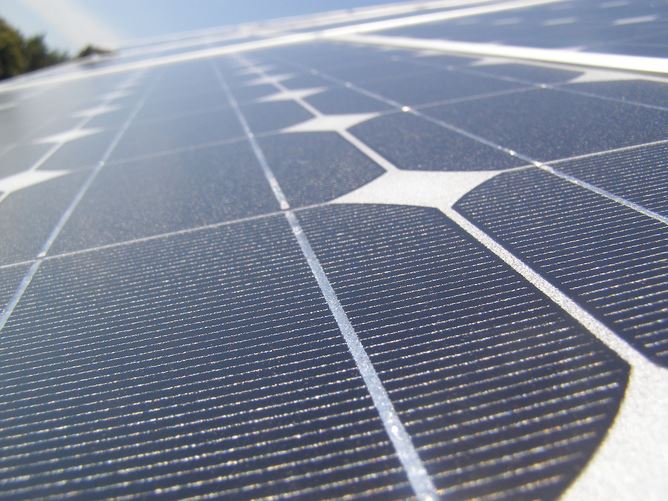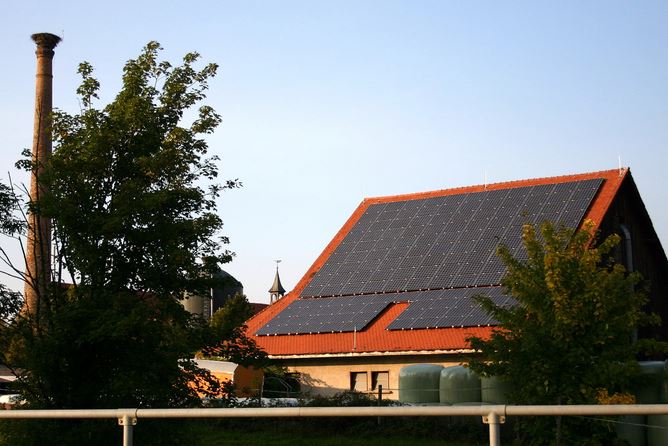
There are two main types of solar energy technology: photovoltaics (PV) and solar thermal. Solar PV is the rooftop solar you see on homes and businesses – it produces electricity from solar energy directly. Solar thermal technologies use the sun’s energy to generate heat, and electricity is generated from that.
Australia receives thousands of times more solar energy from the sun each year than all fossil fuel use combined. We directly use only about one millionth of this at the moment as commercial energy.
How it works
Solar photovoltaic is an elegant technology which produces electricity from sunlight without moving parts.
In a photovoltaic cell, sunlight detaches electrons from their host silicon atoms. Tiny packets of light energy called photons are captured by electrons, and impart enough energy to kick the electron free of its host atom. Near the upper surface of the cell is a “one way membrane†called a pn-junction. The pn-junction is formed by diffusing tiny quantities of phosphorus to a depth of about one micrometre into a thin wafer of silicon.
When a free electron crosses the pn-junction it cannot easily return, causing a negative voltage to appear on the surface facing the sun (and a positive voltage on the rear surface). The front and rear surfaces can be connected together via an external circuit in order to extract current, voltage and power from the solar cell.
Solar cells are packaged behind glass to form photovoltaic modules, which have typical service lives of 20 to 40 years.

In many circumstances, photovoltaic modules mounted on building roofs can produce as much electricity as the building consumes. A typical module will generate about 200 kilowatt hours (AC) per square meter per year, so a collector area of 25-50m2 is needed to power a reasonably energy-efficient Australian house. Such a house exports more electricity to the grid during the day than it imports at night.
An additional 10m2 is required to offset the annual greenhouse gas emissions of a fuel efficient car emitting 0.2kg of carbon dioxide per km and driving 10,000km per year.
A changing market
The world solar market is dominated by photovoltaics, and most of the world’s PV market is serviced by crystalline silicon solar cells. Up until now PV has found widespread use in niche markets such as consumer electronics, remote area power supplies and satellites.
In recent years there have been dramatic falls in the cost of solar PV and the industry has expanded immensely. Panel prices are now below $1000 per kilowatt and system prices are $2000-3000 per kilowatt. Solar PV electricity is now less expensive than both domestic and commercial retail electricity from the grid. It is approaching cost-competitiveness with wholesale conventional electricity in many places.
The cost of photovoltaic systems can be confidently expected to continue to decline for decades. Current worldwide PV module sales are 30-40 gigawatts per year (approximately equal to the power capacity of the Australian electricity system). In 2012 about one gigawatt was installed in Australia, and nearly one million Australian houses have photovoltaic systems on their roofs. Demand is likely to decline in 2013 following the end of subsidies for purchasing panels, but will resume a long-term growth trend from 2014 because the cost of solar electricity is well below the retail commercial and domestic tariff everywhere in Australia.
Problems in the industry
In recent years photovoltaic production capacity has surged far ahead of demand, which has led to an intense price war and a wave of bankruptcies of high profile PV companies, including former market leader Suntech. Technological innovation is being squeezed by the need of companies to focus on survival. A profound industry shakeout and consolidation is underway. The winners will emerge into a trillion dollar per year industry.
The future of the solar PV industry is driven by the fundamental equation that PV is little constrained by environmental considerations, material supply, land requirements, security considerations, or indeed anything other than price – and price is now (or will soon be) competitive nearly everywhere.
The solar energy revolution
Grid parity for photovoltaics at a retail level has already been achieved for most of the world’s businesses and population. In Australian cities, rooftop solar systems typically produce electricity at a cost of half to two thirds of what domestic and commercial retail electricity usually sells for. This is leading to rapid growth in sales in the residential and commercial sectors without the need for subsidies.

Some people are concerned that more use of variable renewables like solar and wind power will make it hard for the grid to cope – they provide power intermittently but our demand is more constant. However, this concern is misplaced; for example, South Australia now procures nearly 30% of its electricity from wind and rooftop solar and has avoided major problems.
This is because many options are available for managing fluctuations in the amount of energy provided by wind and photovoltaics, including shifting demand from night to day (the opposite of what is done at present), using a range of renewable energy technologies and mass storage including pumped hydroelectric storage (by far the leading energy storage technology worldwide).
![]()
Andrew Blakers, Director of the Centre for Sustainable Energy Systems (CSES) , Australian National University
This article was originally published on The Conversation. Read the original article.









